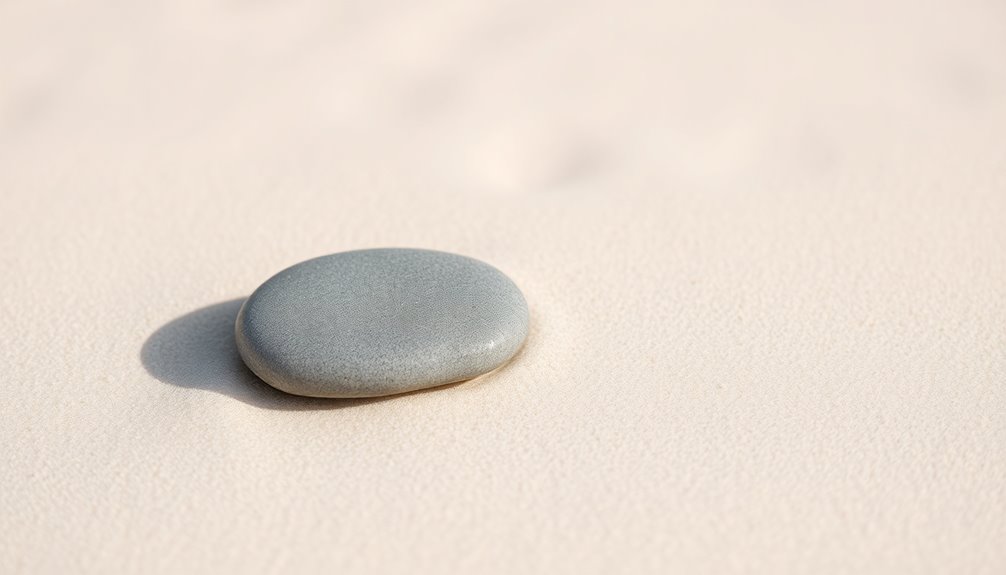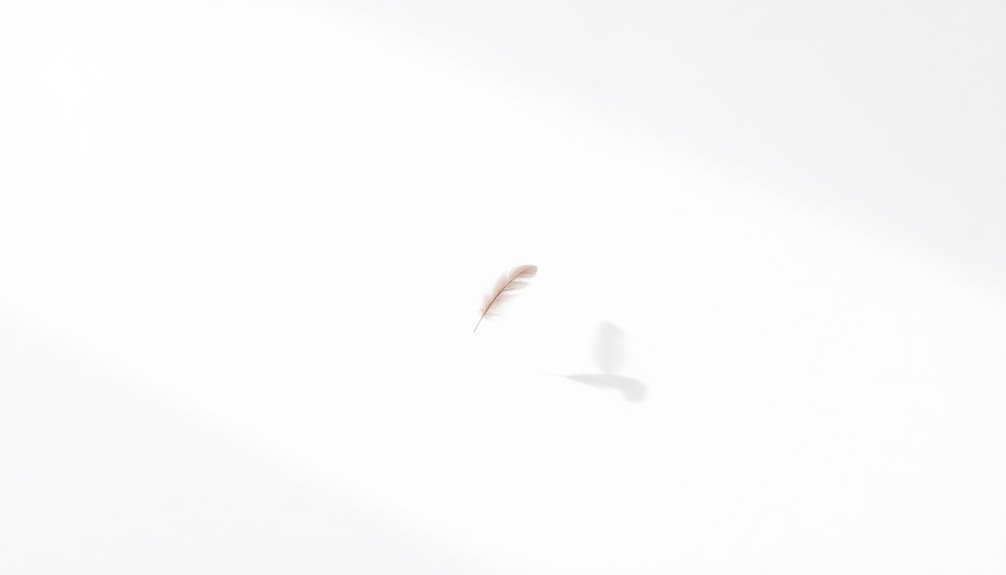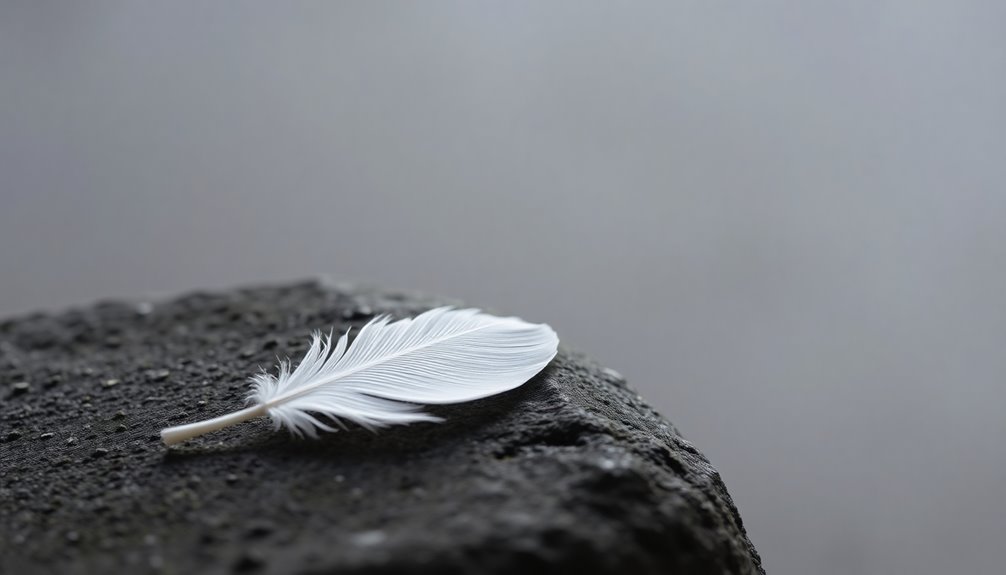Like a Zen garden, minimalist photography invites you to embrace simplicity and clarity in a world full of chaos. You might wonder how a single subject can evoke such depth and emotion. By stripping away distractions, this art form allows you to connect with the essence of the moment. Discover how the principles of minimalism can transform your perspective and enhance your visual storytelling.
Key Takeaways
- Minimalist photography emphasizes simplicity, focusing on a singular subject to create impactful visuals.
- Utilizing negative space enhances composition, drawing attention to the focal point and evoking emotion.
- Limited color palettes and clean lines contribute to a serene and clear aesthetic.
- Strong composition techniques, like the rule of thirds, guide the viewer's eye and enhance storytelling.
- The mastery of camera settings, such as wide apertures and low ISO, enhances clarity and subject isolation.
Understanding Minimalist Photography

Minimalist photography embodies the art of simplicity, drawing your attention to a singular subject while stripping away distractions. This approach focuses on essential elements, using negative space to enhance composition and create a striking visual impact.
By employing clean lines and a limited color palette, minimalist photography evokes emotions and communicates powerful visual storytelling. You'll notice how each component serves a specific purpose, showcasing the beauty in simplicity.
Notable photographers like Michael Kenna exemplify this art form, capturing serene compositions that reflect clarity and tranquility.
As you explore minimalist photography, you'll appreciate how it distills complex ideas into straightforward images, inviting you to engage with the subject on a deeper level while celebrating the elegance of simplicity. Additionally, mastering SEO techniques can significantly improve the visibility of your minimalist photography online.
Core Elements of Minimalism

At its core, the essence of minimalism in photography lies in the deliberate choice of elements that create a powerful visual narrative.
By focusing on simplicity and clarity, you can effectively convey a concept while highlighting the beauty in simplicity. Here are four core elements to take into account:
- Negative Space: Utilize empty space to draw attention to your focal point, creating balance and intimacy.
- Limited Color Palettes: Choose colors deliberately to evoke emotions and maintain focus on the subject matter.
- Isolation of the Subject: Separate your subject from its surroundings to emphasize its importance and enhance storytelling.
- Strong Composition: Use visual elements like lines and shapes to guide the viewer's eye without overwhelming the scene.
Incorporating lighting design can further enhance the minimalist aesthetic by emphasizing key features and creating an inviting atmosphere.
Embrace these principles to enhance your minimalist photography journey.
Equipment and Techniques for Minimalist Photography

To excel in minimalist photography, you need to master essential camera settings and choose the right lens. Focusing on composition techniques will help you create striking images that embody simplicity. Let's explore how these elements come together to enhance your minimalist approach. Additionally, understanding color accuracy can significantly improve the quality of your photographs by ensuring that the hues and tones are represented faithfully.
Essential Camera Settings
Capturing the essence of minimalist photography requires a solid understanding of essential camera settings.
By mastering these settings, you can enhance your composition and visual impact. Here's what you need to focus on:
- Manual Settings: Use manual controls to adjust exposure and achieve perfect simplicity.
- Aperture: Set a wide aperture (f/1.8 to f/4) for a shallow depth of field, isolating your subject and emphasizing form.
- ISO: Keep your ISO low (around 100) to minimize noise and increase clarity, vital for minimalist aesthetics.
- Tripod: Employ a tripod for stability, especially in long-exposure shots, ensuring sharp images with smoothly blurred backgrounds.
In addition, understanding the importance of high-quality protein sources can help you create a more balanced approach to your photography, similar to how nutrition supports overall health in pets.
Don't forget post-processing; fine-tuning contrast and brightness can refine your minimalist images while keeping them simple.
Lens Selection Tips
Mastering camera settings lays the groundwork for effective minimalist photography, but choosing the right lens can elevate your images even further. A prime lens, like a 50mm f/1.8, is perfect for achieving a shallow depth of field, isolating your subject against a pleasing blur.
When capturing minimalist scenes, use a tripod to stabilize your camera for long exposures, enhancing image clarity and smoothing backgrounds. Stick to a low ISO setting, around 100, to minimize noise and maintain that clean aesthetic. Experiment with wide aperture settings, such as f/8, for sharpness and depth.
Consider off-camera flash to highlight specific elements, creating intriguing shadows while preserving the simplicity of your composition. Each lens selection plays an essential role in your minimalist vision. Additionally, using a lens with HEPA filtration can help eliminate dust and particles that may interfere with the clarity of your shots.
Composition Techniques Explained
While the right equipment sets the stage for minimalist photography, effective composition techniques truly bring your vision to life.
Here are four essential elements to take into account:
- Rule of Thirds: Position your subject along the intersecting lines to create a balanced composition.
- Negative Space: Use ample space around your subject to enhance clarity and draw attention.
- Subject Isolation: Employ a shallow depth of field with a wide aperture to minimize distractions, focusing solely on your subject.
- Post-Processing: Fine-tune contrast and color saturation to amplify the visual impact of your minimalist image. Additionally, consider how maximizing space in your composition can further emphasize simplicity and enhance the overall aesthetic.
Types of Minimalist Photography

When exploring types of minimalist photography, you'll find nature minimalism and architectural minimalism stand out.
Nature minimalism captures the essence of single elements, like a lone tree or flower, while architectural minimalism showcases clean lines and structural beauty.
Each type emphasizes simplicity and clarity, inviting you to connect deeply with the subject. Creating cozy spaces through minimalist design can enhance the overall aesthetic and emotional impact of your photography.
Nature Minimalism
Nature minimalism invites you to explore the beauty of singular elements within vast landscapes, where each tree, rock, or body of water stands out in its simplicity.
This style highlights tranquility through the use of negative space, allowing you to engage with the scene's simplicity. Here are some key aspects to contemplate:
- Focal Point: Isolate elements to draw attention.
- Limited Color Palettes: Use soft hues for harmonious balance.
- Natural Light: Capture moments with gentle illumination.
- Shallow Depth of Field: Guide the viewer's eye to your subject.
In nature minimalism, you often capture fleeting moments, emphasizing the emotional impact of nature's impermanence while inviting reflection on time's passage. Additionally, embracing vibrational alignment with the natural world can enhance your appreciation of these serene moments.
Architectural Minimalism
Architectural minimalism celebrates the elegance of simplicity in design, showcasing clean lines and geometric shapes that define modern structures.
By utilizing negative space, you create a visual experience that highlights these forms, allowing balance and harmony within your composition.
Monochromatic palettes enhance this focus, stripping away visual clutter to reveal intricate details often overlooked.
This approach invites you to engage deeply with the architecture, encouraging a depth of contemplation about the relationship between space, light, and the built environment.
When you capture architectural minimalism, you convey a sense of tranquility and clarity that resonates with viewers, emphasizing the beauty found in simplicity and the thoughtful arrangement of space around each structure. Additionally, incorporating elements of herbal infusion machines can add a unique twist to minimalist photography by showcasing functional beauty in everyday objects.
The Impact of Minimalism on Visual Storytelling

Minimalism in photography transforms how you perceive visual storytelling by stripping away unnecessary elements to reveal the essence of a subject. This approach allows you to engage on a deeper emotional level, creating impactful visuals that resonate.
Minimalism in photography unveils the essence of subjects, fostering deeper emotional connections and creating resonant, impactful visuals.
Here are key aspects of minimalist photography's impact:
- Negative space enhances narrative clarity, focusing attention on the subject.
- Limited color palettes evoke specific emotions, enriching the storytelling experience.
- Simplicity in composition turns everyday scenes into profound visual narratives.
- Notable photographers, like Michael Kenna, showcase how careful arrangement of light and space conveys complex themes.
Moreover, the practice of decluttering spaces in your surroundings can significantly influence the effectiveness of your minimalist photography by fostering a clearer mindset and enhancing creative focus.
Mastering Composition in Minimalist Photography

When you master composition in minimalist photography, you release the potential to create striking images that resonate deeply with viewers.
Focus on the rule of thirds, positioning your main subject along these gridlines to instill balance and visual interest.
Utilize negative space to accentuate your subject, fostering a sense of openness that invites engagement.
Incorporate leading lines that guide the eye toward your subject, enhancing the visual narrative of your work.
A limited color palette can amplify clarity and simplicity, allowing the viewer to appreciate the form and texture without distraction.
The Emotional Resonance of Minimalist Images

Stripping away the clutter in your compositions doesn't just enhance visual appeal; it also taps into the emotional depth of your images.
Minimalist photography invites viewers to engage deeply, fostering an intimate connection through:
- Negative Space: Emptiness around your subject creates balance, enhancing emotional resonance.
- Simplified Compositions: These allow personal interpretation, letting viewers project their feelings onto the image.
- Color Choices: Limited palettes can manipulate mood, guiding perceptions and enhancing impact.
- Mindfulness: The meditative quality of minimalist images offers a visual respite, promoting appreciation for simplicity.
Exploring the Intersection of Minimalism and Technology

As technology continues to evolve, it profoundly influences how photographers approach minimalist art. Advances in camera technology, like higher resolution sensors, give you greater clarity and control over compositional elements, enhancing your minimalist approach.
Digital editing tools allow you to refine negative space and adjust color balance, helping convey your desired aesthetic. Online platforms not only provide exposure but also foster community engagement, enabling you to share ideas and work with a global audience.
Additionally, mobile photography applications make experimenting with minimalist techniques more accessible than ever, allowing you to capture inspiration on-the-go. This intersection of minimalism and technology encourages the exploration of new styles, pushing the boundaries of traditional practices while aligning with contemporary trends in photography.
Frequently Asked Questions
What Is Simplicity and Minimalism in Photography?
Simplicity in photography means focusing on essential elements while eliminating distractions. You capture the essence of your subject by using clean lines and negative space.
Minimalism takes this further, emphasizing "less is more." You create powerful images by limiting colors and clutter.
Strong composition techniques, like the rule of thirds, guide your viewer's eye and maintain balance.
Ultimately, you engage your audience through the beauty found in simplicity and intentionality.
What Is the Rule of Simplicity in Photography?
When it comes to photography, you've gotta keep it simple, right?
The Rule of Simplicity emphasizes stripping down your compositions to just the essentials. This means focusing on your subject, using negative space to enhance its prominence, and employing strong lines to guide the viewer's eye.
A limited color palette can also amplify emotional impact. By applying this rule, you invite viewers to engage more deeply with your work, rather than feeling overwhelmed.
How to Take a Simplicity Photo?
To take a simplicity photo, start by choosing a clear focal subject that stands out.
Use negative space to surround it, highlighting its importance.
Experiment with composition techniques, like the rule of thirds, to create balance.
Stick to a limited color palette to keep the focus sharp and evoke emotions.
Finally, use a wide aperture for a shallow depth of field, isolating your subject and ensuring it captures attention effectively.
What Is the Essence of Minimalist?
Did you know that over 70% of people feel more relaxed in minimalist environments?
The essence of minimalist design lies in its simplicity and focus on essential elements. You strip away the clutter, allowing your mind to breathe and engage with what truly matters.
Conclusion
In a world overflowing with noise, minimalist photography offers a revitalizing pause. By stripping away distractions, you reveal the beauty in simplicity, transforming ordinary moments into extraordinary narratives. Each image invites you to contemplate both the singular subject and the vast emptiness surrounding it, creating a powerful dialogue between presence and absence. Embracing this art form not only sharpens your vision but also deepens your appreciation for the subtle intricacies of life, reminding you that less can indeed be more.









